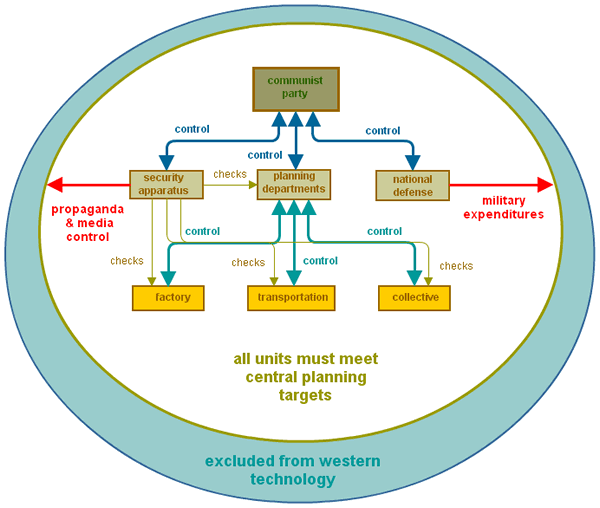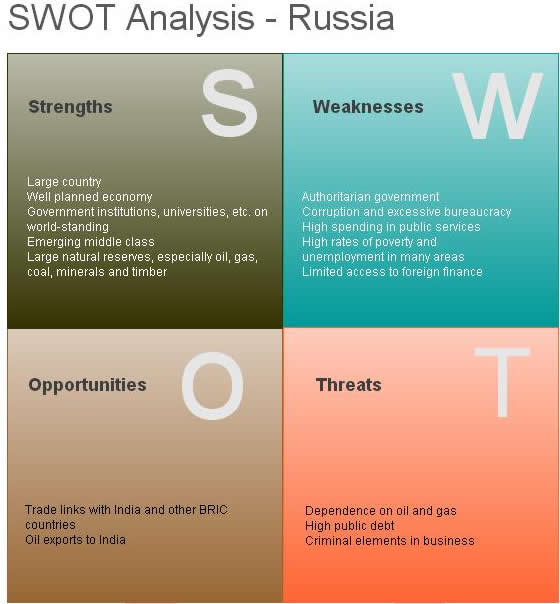 Section
Navigation
Section
Navigation
3. eBusiness Prospects3.1 B2C: North America
3.2 B2C: South America
3.3 B2C: Europe
3.4 B2C: Middle East & Africa
3.5 B2C: Asia
3.6 B2B
3.7 m-Commerce
3.8 Modeling Trends
3.9 USA forecasts
3.10 China forecasts
3.11 EEC forecasts
3.12 India forecasts
3.13 Japan forecasts
3.14 UK forecasts
3.15 Russia forecasts
3.16 Brazil forecasts
3.17 World forecasts
 3.15
Russia Economic Forecasts
3.15
Russia Economic Forecasts
Economic breakdown, war weariness, and discontent with the autocratic system of government overthrew the czarist government, but the coalition of liberals and moderate socialists brought to power was itself overthrown by the Bolshevik coup d'etat of 25th October 1917. Rule was thenceforth through the communist party, and repression was part of the system, from Lenin to Gorbachev, though most markedly in the Stalin era when the country was brutally industrialized. Economic growth was mixed but by no means unsatisfactory till the 1980s, {18} however, after which all aspects languished until the Gorbachev reforms, which quickly and unexpectedly led to the breakup of the Soviet empire. {1-10}
What remained of the country was inaugurated as the Russian Federation in January 1992, but the country lost its superpower status as satellite states declared their independence. The socialist central planning and state ownership of property was scrapped, and a new economy was built on capitalist principles. Responding to an abortive coup, Boris Yeltsin dissolved the Russian parliament in September 1993, and a new constitution was approved in December 1993, which retained Yeltsin as a dominant figure but allowed representation of a broad array of opinion: ultra-nationalists, liberals, agrarians, and communists. Yeltsin resigned at the end of 1999, and Vladimir Putin was named Acting President. In March of the following year, Putin won election in his own right as Russia's second president with 53% of the vote, and moved quickly to reassert Moscow's control. The previous eight years of changes towards a western market economy had been devastating, with the Russian populace suffering as badly as had the Americans in the Great Depression. Putin stopped the spiral of hyperinflation, stabilized the government, and pushed through reforms in banking, labor, and private property. The bloody civil war in Chechnya was brought to an end, and relations with the USA improved after 9/11, when the two countries recognized common terrorist problems. The New START Treaty of 2011 reduced deployable nuclear weapons; the 123 Agreement established a legal framework for joint work on peaceful uses of nuclear energy; NATO, the US and Russia cooperated in common policies towards Afghanistan and Iran. {4-10}
Contemporary Picture
Economic problems of the 1990s included difficulties in raising government revenues, a dependence on short-term borrowing to finance budget deficits, lower prices for its oil and mineral exports, and capital flight exacerbated by the Asian crisis. The ruble declined 60% in value, foreign investment left the country, payments on private and sovereign debt were delayed and the commercial banking system broke down. The economy recovered quickly from the 1998 crisis, however, and achieved 9 years of sustained growth averaging some 7%/year, a success helped by a devalued ruble, reform in tax, banking, labor and land codes, a tight fiscal policy, and favorable commodities prices. Household consumption and capital investments both grew by some 10%/year during this period, and replaced net exports as the main drivers of demand. Foreign exchange reserves had grown to almost $600 bn by mid-2008, the third-largest in the world. The country repaid its entire Soviet-era Paris Club debt of $22 billion in late 2006, but by October 2008 had foreign external debts of $540 billion, of which $500 billion was owed by banks and corporations, including state-owned enterprises. {7-10}
SWOT Analysis
Strengths {11}
Large country
Well planned economy
Government institutions, universities, etc. of world-standing
Emerging middle
class
Large natural reserves, especially oil, gas, coal, minerals and timber
Weaknesses
Authoritarian
government {19}
Corruption and excessive bureaucracy
High spending in public
services
High rates of poverty and unemployment in many areas
Limited access
to foreign finance
Opportunities
Trade links with India and other
BRIC countries
Oil exports to India
Internal Threats
Dependence
on oil and gas
High public debt
Criminal elements in business
Weakness: Financial Instability
The global economic crisis hit Russia hard. Capital flight in September 2008 caused a crisis in its stock market, one not helped by business disputes like TNK-BP and Mechel, and the Georgian war. The market collapsed in mid September as businesses sold shares to raise collateral for margin calls required by international lending institutions. GDP growth ground almost to a halt in the fourth quarter of 2008, down to 1.1% (from 9.5% during the same period in 2007). The Central Bank of Russia averted a banking crisis by pumping liquidity into Russian banks, and staging a managed devaluation, one which avoided bank runs but reduced foreign exchange reserves to $387 billion in mid February 2009. This prompted the S&P and Fitch rating agencies to downgrade Russia's sovereign debt to the lowest investment grade. {9}
By 2010, however, the Russian economy had begun a modest recovery, bolstered by government policies and a rise in oil prices. Renewed emphasis was placed on innovation, modernization and diversification away from dependence on oil and gas. {9}
Soviet Model

The Soviet model was based on state control of investment, public ownership of industrial assets, collective farming and centralized administration. The reasons commonly given to explain the failure of the Soviet economic model generally include a failure to provide:
1. Proper incentives: the cradle to grave care supported
everyone regardless of talent or effort.
2. Sufficient human rights: citizens
were given free education, free health care and work but not the freedom to criticize
the system.
3. Accountability: management became increasingly bureaucratic and
divorced from everyday needs.
4. Access to alternative ideas: citizens were kept
ignorant of more successful (western) models.
Equally important after 1945, however, were: {12}
1. A ban on transfer of technology to the USSR.
2. Trade embargoes
on USSR goods.
3. Diversion of economic effort to the arms race.
4. Corruption
and loss of vision by the centralizing bureaucracy. {13}
5. An inflexible administration
overwhelmed by the needs of a modern society. {7}
Outlook
Tighter credit, collapsing global demand, global uncertainty, and rising unemployment have hurt investment and consumption, leading to a -7.9% GDP growth in 2009, a striking contrast to the pre-crisis performance of 8.1% in 2007. Russia returned to growth with a 4.2% increase in GDP in 2010, the third highest growth rate among the world's leading economies, and the government prediction is for 3.7% growth in 2012. {20} Growth in fact was 3.5%, though higher rates are predicted for 2013 and beyond. {22}
Russia now has a stable market-based economy, which in 2013 was the thirteenth largest in the world. Some 10% of the population work on the land (accounting for 5% of GDP), and agricultural reforms have turned the country into a grain exporter. Some 32% work in the industrial sector (accounting for 34.8% of GDP) and, of these a fifth in the armaments sector, making Russia the second-largest conventional arm exporter. The service industries account for 58% of GDP, employing 45 million people in retail, tourism and advertising. Unemployment is still high, as is percentage below the poverty line: some 11 million people lack a proper source of income. {21} Russia joined the World Trade Organization in 2012, reducing trade barriers and helping to open foreign markets for Russian goods. {23}
eBusiness Implications
Petroleum has restored Russia to superpower status, {14} and the industry increasingly uses Internet-based systems in all aspects of exploration, oil field development, delivery and staff safety. There are many systems on the market: e.g. Fielding Systems, vMonitor, Merrick, eLynx, etc. Petrotechnics, for example, has rolled out an electronic integrated safe system of work for the Sakhalin Energy Investment Company. The web-based solution is implemented at four sites, and integrates work permits, risk assessment and isolation management, delivering results to the front-line user in through a real-time graphical implementation. {15} Baker Hughes, operating out of sixteen Russian cities, provides oil reservoir evaluation and related services. {16} Production data is indeed being placed in the public domain through websites. {17} Some rig controls are open to cyber-manipulation. {24}
 Points to
Note
Points to
Note
1. Rocky path from centrally planned to capitalist system.
2. Battle
with predatory banking system.
3. Debate over reasons why the Soviet model failed.
 Sources
and Further Reading
Sources
and Further Reading
1. A History of Russia by Nicholas
Riasanovsky and Mark Steinberg. O.U.P. 2010.
2. A History of the Soviet Union
from the Beginning to the End by Peter Kenez. C.U.P. 2006.
3. The Penguin
Historical Atlas of Russia by John Channon and Robert Hudson. Puffin 1995.
4. Russian and Soviet History. History
Orb 2012.
5. Seventeen Moments in Soviet History. SovietHistory.Org.
6. Soviet History Archive. Marxists.Org.
Accessed September 2012.
7. Economy of the Soviet Union. Wikipedia.
September 2012.
8. Economy of Russia. Wikipedia.
September 2012. September 2012.
9. Russia Economy. Economy
Watch. 2012.
10. Background Note: Russia. Bureau
of European and Eurasian Affairs. US Dept. of State. March 2012.
11. SWOT
Analysis on Russia's Economy. AcademicWritingTips.
Accessed August 2012.
12. The Soviet Model and the economic cold war by
Marcus Mulholland. 21st
Century Socialism. December 2006.
13. The Future that Failed by J.P.
Arnason. Dajilai.
Routledge, 1993. p. 194.
14. From Soviet to Putin and Back by Michael J.
Economides and Donna Marie D'Aleo. Energy Tribune Publishing Inc. 2008.
15. Petrotechnics Completes 1st Russian System Roll Out. Petrotechnics.
September 2010.
16. Products and Services. Baker
Hughes. Accessed August 2012.
17. Oil & Gas Eurasia first site to go "live"
within BPA's web traffic tool; beta test continues with 100+ sites tagged. Oil
and Gas Eurasia. October 2008.
18. Reassessing the Standard of Living
in the Soviet Union: An Analysis Using Archival and Anthropometric Data by Elizabeth
Brainerd. Williams
College. July 2008.
19. Web Offensive Russia Battles Online Foes and Freedoms
by Benjamin Bidder. Der
Spiegel. August 2012.
20. Russia: Annual real gross domestic product (GDP)
growth rate from 2002 to 2012. Statista.
April 2012.
21. Russia Economy 2013.
Altius Directory.
22. 2013: Lucky or unlucky for the world economy?
RT. January 2013.
23. Russia Economy 2013 . Theodora.
February 2013.
24. System Failure: Cyber Threats & Corporate Denial by Greg
Guma. Maverick
Media. June, 2013.
 Sources
Sources